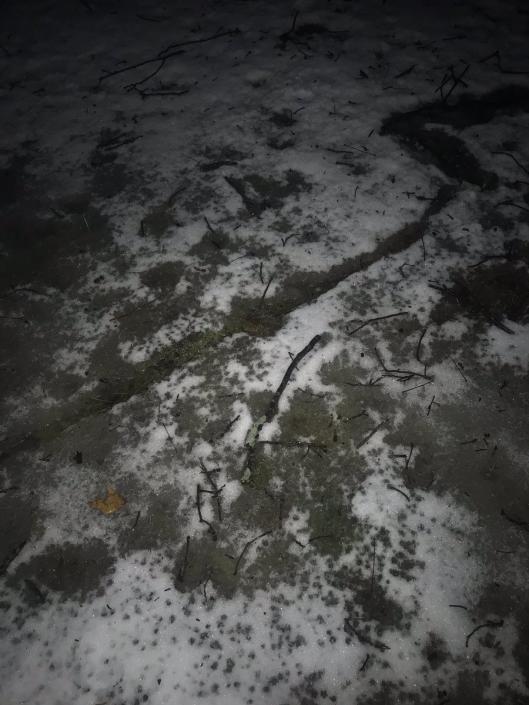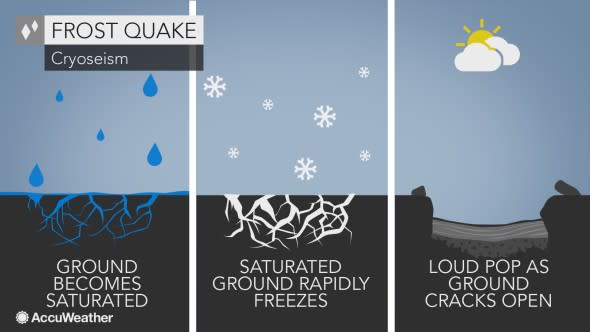How loud booms can fool people into thinking there's an earthquake when it's very cold
During extreme cold events, you may hear a loud boom and you may feel like you experienced an earthquake.
However, this event was more likely a cryoseism, also known an ice quake or a frost quake.
During the recent polar vortex that invaded the northeastern and midwestern United States, frost quakes were reported throughout the affected regions, including Pennsylvania, Illinois, Indiana and Iowa.
For example, Chicago residents reported hearing "loud booms" Wednesday night when temperatures in the area reached well below zero. What they heard were most likely frost quakes, WGN-9 reported.
Frost quakes in extreme cold
AP Photo/Garret Fischer



First, at vero eos et accusamus et iusto odio dignissimos ducimus qui blanditiis praesentium et accusamus et iusto odio dignissimos ducimus qui voluptatum.




(Twitter/ @kthellm)
Photo captured frost quake evidence in the Prospect, Connecticut, area on Thursday, Jan. 24, 2019.

(Twitter/ @kthellm)
Photo captured frost quake evidence in the Prospect, Connecticut, area on Thursday, Jan. 24, 2019.

(Twitter/ @kthellm)
Photo captured frost quake evidence in the Prospect, Connecticut, area on Thursday, Jan. 24, 2019.

Frost quakes are often mistaken for earthquakes because the initial indicators may appear similar to those of an earthquake, including tremors, vibrations, ground cracking and related noises, such as thundering or booming sounds.
However, frost quakes are not related to earthquakes, the movement of tectonic plates, volcanoes or other factors that are unrelated to surface temperature.
There is no such thing as "earthquake weather," with an equal distribution of earthquakes in cold, hot, dry or rainy weather, the U.S. Geological Survey (USGS) said.
Frost quakes occur because water naturally trickles down into the ground, and during winter, water close to the surface will freeze due to the colder air above.
"However, during periods of extremely cold weather, the water further underground can also freeze, and when it does, it expands. This expansion puts stress on its surroundings, which can be released explosively in the form of a frost quake," said AccuWeather Meteorologist Derek Witt.
This is similar to the way in which an earthquake occurs. However, instead of tectonic plates grinding against each other, it's ice against the underground soil.
"Therefore, frost quakes can happen almost anywhere that extremely cold weather is present, as it's not a seismic event related to tectonic plates. Frost quakes are most common the Northeast, Great Lakes region and Alaska," Witt said.
The best conditions for a frost quake occur when a very cold air mass moves over a recently saturated surface, typically from melting snow or rain. In addition, minimal snow cover allows the cold to permeate further underground and a rapid drop in temperature causes the water underground to freeze more quickly, according to Witt.

Frost quakes usually occur between midnight and dawn, the coldest part of the night. They can occur over several hours and even several days, the Maine Geological Survey said.
"For the most part, frost quakes are harmless events that may startle an observer. A frost quake may sound like a cracking or booming noise. They may also sound like a distant rumbling, similar to hearing thunder a distance away from a thunderstorm," Witt said.
A few small surface cracks and light damage, such as pictures falling off walls and unstable objects falling over, are possible during frost quakes. However, effects of that magnitude are quite rare.
There have been a few cases reported in the northeastern U.S. where people have been able to find a small crack in the ground where the cryoseism occurred. In these cases, it appears that the cracks are caused by the ground having contracted rapidly due to the sudden cold and split apart, according to the Maine Geological Survey.


